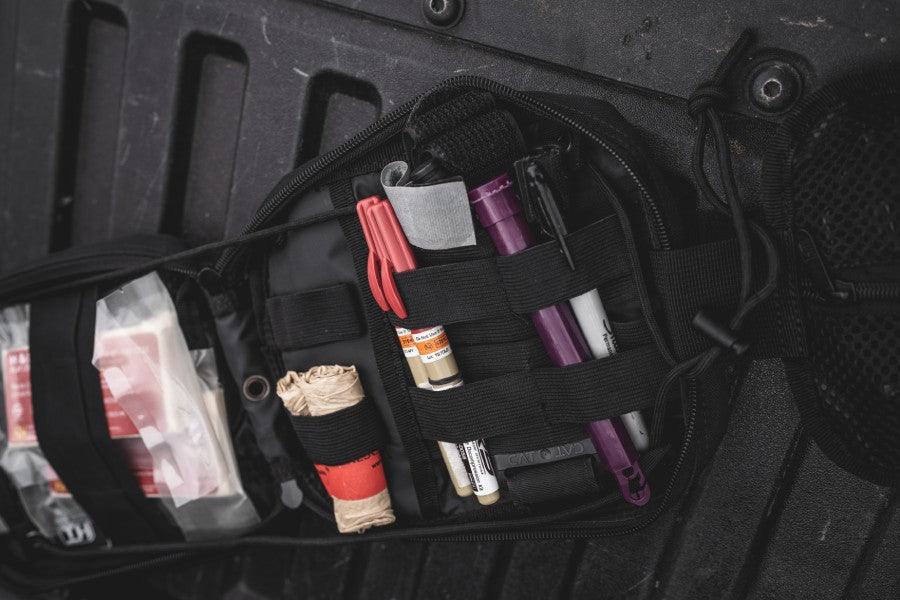What Should Be In An IFAK?

Individual first aid kits (IFAKs) are designed for use by military personnel, law enforcement officers, and first responders who may need to provide critical medical care during emergencies. There is careful consideration and planning when determining what should be in an IFAK.
IFAKs are specially designed to meet the needs of individuals who are at risk of sustaining serious injuries in high-stress situations. Combat first aid kit contents can be useful for other adventurous individuals who engage in high-risk or extreme outdoor activities, such as hiking, rock climbing, or hunting.
Having a tactical first aid kit on hand will help you take care of injuries that may occur. Your military medical kit contents can prevent them from becoming severe. Keep in mind that combat medic kit contents are not a substitute for proper medical assistance.
You should build a tactical first aid kit that suits you and your needs. We like our Rip Away Med Pouch as a foundation for our medical kit - then we build up from there depending on the anticipated needs. When selecting what should be in an IFAK, remember that military medical kit contents cater to two main needs: stopping bleeding and clearing airways that may be obstructed.
10 Things That Should Be in an IFAK
Your tactical first aid kit list will vary based on your exact needs. However, here is a list of what we think should be in every IFAK:
1. Nasopharyngeal Airway (NPA)
This is a vital part of an IFAK for airway management. This device is used for the insertion and removal of an airway through the nose and mouth. NPAs are usually made from a soft, flexible material that can easily be inserted through the nose or mouth without causing damage to surrounding tissue.
2. Trauma Shears
Trauma shears are an essential tool for emergency medical care because they can be used to cut through clothing, seatbelts, and thick materials. These shears are specially designed for these situations where you may need to remove clothing or other obstructions to a wound.
3. Combat Application Tourniquet (CAT)
CAT tourniquets are specialized tourniquets used to stop bleeding from a limb. They are made to be applied with one hand, making them efficient in high-pressure situations. These tourniquets work by compressing the limb to stop and control the flow of blood to prevent further blood loss. They are generally made from nylon or rubber with a compact design.
4. Gloves
Gloves are an important item that should be in an IFAK. These can be latex or nitrile gloves. Latex free is your best and safest bet if you are worried about a latex allergy. They are meant to keep you, as the first aid responder, safe when treating an injured person to ensure bodily fluids and bacteria aren’t transferred from person to person.
5. Medication
Various medications for different treatments should be in IFAK. This includes pain medication like acetaminophen, ibuprofen, or aspirin for general pain management. Allergy medication like an EpiPen which administers epinephrine in emergency situations can also be helpful in an IFAK.
6. Hemostatic Agents
Hemostatic agents are a valuable part of any IFAK. These agents are used to control bleeding by speeding up blood clotting. This is to seal off a wound to prevent more blood loss. These agents come in many forms including hemostatic gauzes, sponges, and powders.
7. Bandages
Bandages are the most common items that should be in an IFAK. There are many types of bandages with different uses:
- Butterfly bandages: These are adhesive bandages used in lieu of stitches to treat cuts and lacerations.
- Triangular bandages: These are used as a sling or to secure splints.
- Roll gauze bandages: These are woven strips of combat gauze rolls or elastic bandages.
- Chest seals: These bandages are best for deep puncture wounds.
8. Wound Dressing
Occlusive dressing is a type of dressing that keeps wounds dry, especially in wet environments. They protect wounds from contamination, reducing the risk of infection. The pressure dressing is also used in conjunction with items like a tourniquet to stop bleeding.
9. Aluminum Splint
Aluminum splints are an easy device used to support injured joints or bones. They are made from thin, pliable sheets of aluminum and can be bent in the shape of the affected limb. Splints stabilize fractures from dislocated fingers, hands, or wrists. They are secured in place with bandages or adhesive tape, which is our next must have item.
10. Adhesive Tape
Adhesive tape is a versatile item so it’s a must for a compact IFAK. They can secure and hold dressings and gauze pads in place. They can also immobilize injuries by creating splints or closing small wounds or lacerations.
Prepare Your IFAK the Right Way
Context will determine your medic bag content list. Now that you know what should be in an IFAK, you can select the best tactical medic bag for your medical gear. A tactical medical kit can serve you well in your everyday travel or during your outdoor adventures.

